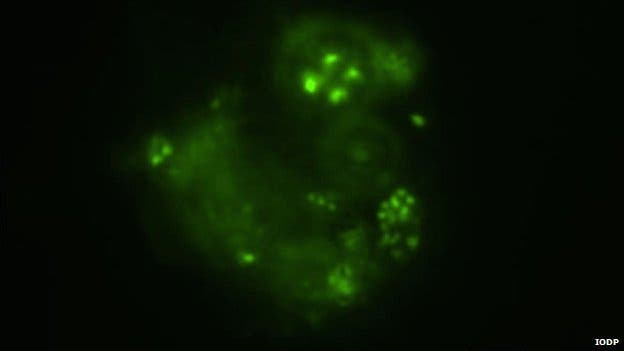An expedition that drilled 2,400m beneath the seabed off Japan – the deepest marine drilling ever – found life in cores brought back to the surface. The tiny, single celled organisms survived there without any oxygen or light, relying only on a harsh diet of hydrocarbons to make means. Because of the limited resources available to them, the organisms have an extremely slow metabolism. Despite this, it’s remarkable how resilient life can be, never ceasing to surprise us.
Life trapped in rock beneath the ocean

Elizabeth Trembath-Reichert, from the California Institute of Technology, who is part of the team that carried out the research, said to the BBC: “We keep looking for life, and we keep finding it, and it keeps surprising us as to what it appears to be capable of.”
The International Ocean Discovery Program (IODP) performed their drilling in 2012 off the coast of Japan’s Shimokita Peninsula in the northwestern Pacific. A monster drill was flung into the ocean from a behemoth-sized ship called Chikyu, where it took 1000m to reach the ocean floor. Once there, the drill penetrated through 2,446m of rock under the seafloor, setting a new record for this kind of marine exploration.
The purpose of the expedition was to see whether they could find life at extreme depths, well beyond the seafloor. The team didn’t drilled randomly, though, and chose their drilling target with caution. Buried deep by thousands of feet of rock and soil, absent light and oxygen, life has only so few options to survive. Life must at least have access to carbon to feed upon, so the expedition’s safest bet was to drill in these coal beds. Once they actually found the microbial life, researchers couldn’t help but wonder whether these organisms fed on smaller organic compounds like methane and other types of hydrocarbons sourced from the coal.
To put this idea to the test, the microbes were fed with different compounds. Indeed, these little, spherical organisms could ingest the methyl compounds. The same tests also revealed that the microbes took it very easy, having an extremely slow metabolism, which was expected really given their habitat.

Next, the expedition plans a new drilling round to see whether there are more types of microbes living beneath the seabed. More importantly, they’re trying to determine how in the world those microbes got there in the first place.
“Were these microbes just in a swamp, and loving life in a swamp, because there is all sorts of carbon available, oxygen, organic matter… and then that gets buried?” pondered Dr Trembath-Reichert.
“It could be that they didn’t get a chance to escape – they couldn’t exactly walk out. So is it that they were there to begin with and then they could maintain life?
“Or were they like microbes that were able to travel down to those depths from the surface?”
There’s much to learn from extremophiles living deep below Earth’s surface or seabed. For one, because these organisms feed on hydrocarbons, they produce methane as a byproduct which is a greenhouse gas thousands of times more potent than CO2 at trapping heat. How many of these organisms are there below the oceans? Billions, trillions, billions of billions? We need to know if we’re to build a solid model that faithfully assess their impact on the climate.
If you think life found at 2,4 km below the surface is incredible, wait till you hear about a similar find … only at 20km deep. Granted, they didn’t find organisms per se, but signature traces – minerals flushed with microbial methane. With all this in mind, one can only wonder: what’s the absolute limit where life can be sustained? We might never know for sure, but we’re sure stretching it.






